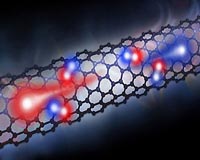 |
Washington DC (SPX) Oct 27, 2010 Just as landscape photographs shot in low-angle light dramatically accentuate subtle swales and mounds, depositing metal vapors at glancing angles turns a rough surface into amazing nanostructures with a vast range of potential properties. For decades, vapor deposition has been a standard technique for creating modern microelectronic circuits. But nearly all of industry's efforts have been devoted to making structures as flat and smooth as possible. Rather than placing metal sources in the high-noon position used to make featureless structures, Daniel Gall of Rensselaer Polytechnic Institute is one of several dozen research leaders who place them at very narrow angles akin to sunrise or sunset illumination. Metal atoms then hit primarily any high spots on the target surface. Continued deposition creates a forest of nanorods, rather than flat films, since each growing rod shadows a volume behind it. Starting with a patterned substrate yields a regular array of nanoscale columns, like skyscrapers in downtown Manhattan. Gall describes his research at the AVS 57th International Symposium and Exhibition, which took place last week at the Albuquerque Convention Center in New Mexico. In his talk, Gall reveals a new theory that predicts how the deposition temperature and diffusion affects the diameters of the nanorods. "Atoms moving by surface diffusion typically smooth the surface," Gall says. "Atomic shadowing causes the opposite effects, making the surface rough. Glancing-angle deposition extends shadowing effects to higher temperatures, which lead to larger-diameter nanorods." He also illustrates his presentation with images of a variety of nanostructures created in his lab, including curiously shaped half-moons made when he started with a pattern of self-assembled spheres. Future applications for nanorod structures such as Gall's include nanosensors, optical elements, fuel-cell cathodes and electrical contacts for buffering thermal expansion.
Share This Article With Planet Earth
Related Links American Institute of Physics Nano Technology News From SpaceMart.com Computer Chip Architecture, Technology and Manufacture
 Nanotube Thermopower Offers Promise
Nanotube Thermopower Offers PromiseWashington DC (SPX) Oct 27, 2010 When weighing options for energy storage, different factors can be important, such as energy density or power density, depending on the circumstances. Generally batteries - which store energy by separating chemicals - are better for delivering lots of energy, while capacitors - which store energy by separating electrical charges - are better for delivering lots of power (energy per time). It wou ... read more |
|
| The content herein, unless otherwise known to be public domain, are Copyright 1995-2010 - SpaceDaily. AFP and UPI Wire Stories are copyright Agence France-Presse and United Press International. ESA Portal Reports are copyright European Space Agency. All NASA sourced material is public domain. Additional copyrights may apply in whole or part to other bona fide parties. Advertising does not imply endorsement,agreement or approval of any opinions, statements or information provided by SpaceDaily on any Web page published or hosted by SpaceDaily. Privacy Statement |